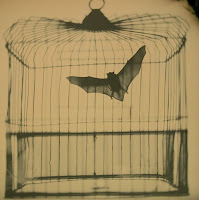The price of silence and the myth of the Batt Cage
 Way, way back in 2004, the IPKat posted this item on the always controversial and often instructive copyright claim by composer John Cage to "4'33", a piece that consists of 4 minutes and 33 seconds of absolute silence. The choice of title is actually quite clever: the silence adds up to absolutely nothing, and a minutes 33 seconds has an arithmetical value of 273 seconds -- equivalent to the temperature of minus 273 degrees on the Celsius scale. As for the copyright claim, the IPKat's friend, author and scholar Rebecca Giblin ("contact hours, by appointment"), has a bit of news for us. This may come as a shock, so brace yourselves:
Way, way back in 2004, the IPKat posted this item on the always controversial and often instructive copyright claim by composer John Cage to "4'33", a piece that consists of 4 minutes and 33 seconds of absolute silence. The choice of title is actually quite clever: the silence adds up to absolutely nothing, and a minutes 33 seconds has an arithmetical value of 273 seconds -- equivalent to the temperature of minus 273 degrees on the Celsius scale. As for the copyright claim, the IPKat's friend, author and scholar Rebecca Giblin ("contact hours, by appointment"), has a bit of news for us. This may come as a shock, so brace yourselves:The copyright-in-silence litigation over John Cage’s composition “4’33”” has long made a great yarn. 4’33” was composed in 1952, contains three movements, and can be played by any instrument. The score simply instructs performers not to play their instrument for the duration of the piece. While it’s often described as a “silence” piece, in reality it consists of ambient noise – the shuffling and whispering and shifting that inevitably occurs when you have a concert hall full of people watching musicians not play their instruments.Controversy arose in the early 2000s after British composer Mike Batt published his own composition, “A One Minute Silence”, which he credited to Batt/Cage. This piece similarly required musicians not to play their instruments, and Cage’s publishers controversially threatened to sue Batt for copyright infringement.
BatcCage composition
In September 2002, it was widely reported that the parties had reached an out-of-court settlement under which Batt would pay an undisclosed six figure sum to the John Cage Trust. This triggered widespread outrage at the idea that silence could possibly be protected by copyright, and a number of scholars published indignant critiques of the case in journals around the globe.
The story has been a salutary lesson about the potent dangers of copyright overreach for many of us since. But apparently all was not as it seemed.
I recently stumbled across a write-up in the Telegraph reporting that, in 2010, Mike Batt had admitted on Twitter that the whole thing had been a mischievous set-up intended to “stir debate about copyright issues” [one extremely red-faced Kat, who often reads the Telegraph, missed it: the write-up is here]. Apparently it was true that Cage’s publisher claimed royalties, but backed down quickly once the merits of the case became clear. Nonetheless, Batt claims that they then agreed to disagree publicly. The much-reported six figure settlement? Well, that was not entirely untrue – Batt claims he handed over a cheque for £1,000.00 – that is six figures, right enough, if you count the trailing zeroes. Batt’s view is that it was money well spent:Bat composition with plenty of noise here“There was no court case, no serious litigation. Just a lot of fun between us and lots of press coverage. But let's get this straight: John's silence was inferior to mine. My silence was digital and his was analogue. Also, mine was not played by an eight-piece band and his was not played by a solo clarinet. I think my 1,000 quid was well spent – so long as it didn't subsidise some avant-garde ****er to write more silence and call it art.”So there you have it. It was a great story – but it’s busted".
Cage fighters here
Silencing a cat here
Quiet dog here
Top right illustration by the talented and versatile Roma Gutierrez here

